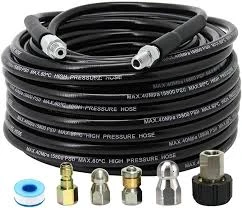high pressure power steering hose replacement
High Pressure Power Steering Hose Replacement
Replacing a high-pressure power steering hose is a crucial maintenance task that ensures the reliability and safety of your vehicle's steering system. The power steering system relies on hydraulic fluid to assist in turning the vehicle's wheels, and a high-pressure hose delivers this fluid from the pump to the steering gear. Over time, these hoses can deteriorate and develop leaks due to wear and tear, heat, or exposure to road chemicals. If left unaddressed, a failing hose can lead to steering difficulties and even complete loss of steering control, posing a serious safety risk.
Signs of a Failing High-Pressure Hose
Before embarking on a replacement, it is important to recognize the signs of a failing high-pressure power steering hose. Common indicators include
1. Fluid Leaks Puddles of reddish or brown fluid under your vehicle can signify a leak. Inspect the hose for cracks or damage. 2. Steering Difficulties If you notice increased effort required to turn the steering wheel, this may indicate a fluid shortage resulting from a leak.
3. Noisy Steering System Whining or groaning noises when turning the wheel can also indicate low fluid due to a faulty hose.
Tools and Materials Needed
To replace the high-pressure power steering hose, you will need the following tools
- A wrench set - Screwdrivers - Pliers - Fluid catch basin - New high-pressure power steering hose - Power steering fluid
Replacement Process
high pressure power steering hose replacement

1. Safety First Begin by disconnecting the vehicle's battery to avoid electrical issues.
2. Locate the Hose Identify the high-pressure hose, which usually runs from the power steering pump to the steering gear.
3. Drain the Fluid Place a catch basin under the steering system to collect any leaking fluid as you disconnect the hose.
4. Remove the Old Hose Use the appropriate wrench to disconnect the fittings on both ends of the hose. Be cautious of residual fluid.
5. Install the New Hose Align the new hose with the fittings, making sure to tighten them securely without overtightening, which can damage the fittings.
6. Replenish Fluid Fill the power steering reservoir with the specified fluid and check for leaks. Start the vehicle and turn the wheel from lock to lock to help eliminate any air from the system.
7. Final Check After ensuring the system is leak-free and functioning properly, reconnect the battery.
Conclusion
Replacing a high-pressure power steering hose is a straightforward task that can save you from costly repairs down the line and ensure your vehicle's steering system operates smoothly. Regular inspections of your power steering system can prevent unexpected failures and enhance driving safety.
-
Understanding Power Steering Tube ReplacementNewsApr.16,2025
-
SAE J1401 Brake Hoses: A Critical Component for Vehicle SafetyNewsApr.16,2025
-
Pipe Couplings: Essential Components for Effective Plumbing and Fluid SystemsNewsApr.16,2025
-
Hose Guard Solutions for Every NeedNewsApr.16,2025
-
Effective Spiral Protection SolutionsNewsApr.16,2025
-
Effective Sewer Cleaning SolutionsNewsApr.16,2025

